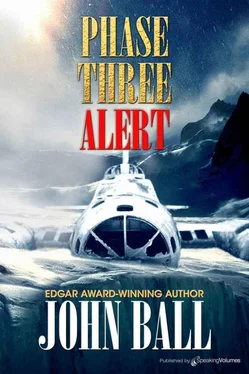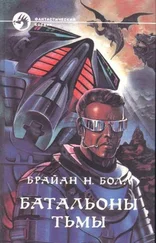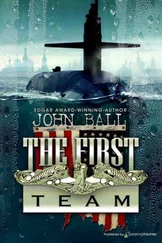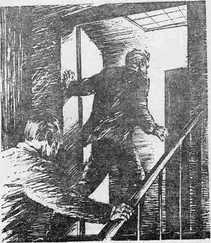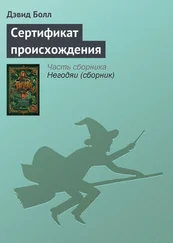In answer an unmistakable flare came up off the ice cap and hung in the air a little to the port side. Forcing himself to keep calm, and aware that the colonel was positioned directly behind him, he hit the transmit button. “Thule radio, this is Air Force three-six-zero.”
“Three-six-zero.”
“We have a flare off the ice cap, positive ID. Our position follows.”
“Penguin ’six-zero, please confirm you have a find.”
“That is affirmative, Penguin ’six-zero.” He stopped and let Jenkins relay their position. Then he checked his altimeter, banked, and began a spiral descent as close as he could to the spot where the flare had appeared. The landing light cut a narrow cone as he reset the transceiver to 121.5 and called: “Otter on the ice cap, do you read? Otter, do you read?”
There was no reply. Holcomb came on the intercom. “He’s probably got complete electrical failure, sir, and that would put him down at night — no instruments. And he wouldn’t be able to start up again.”
It all made sense then. Every man on board the Penguin was looking out, trying to see the unseeable. Ferguson leveled off as close to the invisible top of the ice cap as he dared; as he did so, Sergeant Stovers released a parachute flare. The brilliant light rebounded from the snow-covered ice mass, and Atwater, at the port-side scanning window, let out a yell, “There she is!”
Ferguson racked the Penguin around until he had the Otter in front of the nose, where he could see it clearly. One person was standing beside it; he presumed that would be the pilot who had fired the Very pistol. The aircraft, he noted, had a damaged wingtip.
He had no idea how that had happened, and he didn’t care. As he flew directly over, he rocked his wings as an added reassurance. It never occurred to him to wonder what the pilot on the ground would think when he saw a B-17 overhead; far more pressing matters were on his mind.
Sergeant Holcomb’s voice came into his headset. “On the next pass, we’ll drop some supplies, through the bomb-bay door.”
“Don’t fall out.”
“We won’t.”
He used the radio once more. “Thule, this is Penguin three-six-zero. The Otter has been sighted on the ice cap; there is at least one survivor.”
He got a direct answer to that. “Penguin ’six-zero, this is Jolly Two. We are en route to your position. ETA thirty-six minutes.”
Ferguson acknowledged. “Jolly Two, we will orbit this location at eleven thousand feet true altitude; please advise your altitude.”
“Jolly Two to Penguin, we will approach at twelve thousand with landing light on. Advise when visual contact made. Over.”
Another voice cut in and Ferguson recognized Boyd’s crisp tone. “Penguin, this is C-130. How can we assist? Over.”
Colonel Kleckner tapped Ferguson on the shoulder and took over the right-hand seat. As soon as the colonel was fastened in, Corbin yielded his place so that the aircraft commander could return to where he belonged. As Scott was getting his own harness on, the colonel answered the radio call. “Here niner-four, if your fuel allows, you might come over at thirteen thousand and stand by in case we need you.”
“Here to Penguin, wilco. ETA twenty-eight minutes. Out.”
Thule came in again. “Air Force ’six-zero, Godthaab asks if you have any indication that their medical people aboard the Otter are all right. Over.”
Ferguson responded. “ ’Six-zero to Thule, no data either way as yet, but Otter appears to have only slight damage. More later. Out.”
With both the gear and the flaps down, he slowed the Penguin to what he considered a minimum safe flying speed in the very gusty air. By the last light from the flare he positioned her so that she would pass the Otter seventy or eighty feet off its wingtip. “Ready for drop?” he asked.
“Ready.”
“Stand by.” He let the Penguin descend with her landing lights on until she was barely skimming the ice cap. “Three, two, one — go,” he directed.
Five seconds later Holcomb reported. “Bombs away. It looked good from here.”
“What went?”
“Blankets, hot coffee, food, and a medical kit.”
“Good. That should hold them until the Jolly gets here. Jenk, can you make a good guess as to the surface wind?”
The navigator came back promptly. “I can give you the exact wind. I’ve got a driftmeter and I took a double drift when I had the chance. Zero-six-zero at thirty-three knots.”
Ferguson climbed back up to 11,000 feet and then held steady, swinging in a fixed orbit around the downed Otter. He would have liked to have radioed back more information concerning the people it was carrying, but the HH-3 was due shortly. Less than five minutes later he picked up an approaching landing light in the sky.
He pressed to transmit. “Jolly Two, we have you in sight. Surface wind is zero-six-zero at thirty-three, heavy gusts. Advise if you want flare.” That done, he returned to 121.5 and transmitted. “Otter, if you read, Jolly Green Giant is in sight and will pick you up shortly. Set out a flare or something for her if you can.”
He listened for an acknowledgment, but he did not expect one and none came. He looked again at the incoming helicopter and saw that it was descending rapidly. In less than a minute it passed underneath, aiming for the center of his orbit. Apparently the Otter pilot heard enough of the sound to identify it as a helicopter; a red flare appeared on the surface of the snow and, a few seconds later, another one, a hundred feet from the first.
When he knew that it was safe to do so, Ferguson, descended a little and flew just to the right of the twin flares. By the landing lights of the helicopter he saw the swirling snow whipped up by its main rotor; as he flew past, Tom Collins’s voice came in with sharp clarity. “On the ground, no sweat. Stand by.”
For three minutes Ferguson flew The Passionate Penguin in a close spiral around the marking flares while he waited for further word. He did not realize that the C-130 had arrived overhead until he was almost blinded by the brilliant flare that it released in the sky. Then the whole thing was laid out with photographic clarity: the Otter with a crumpled wingtip, the big Sikorsky close by with its rotor still turning, and three people on the ice cap moving from the Otter toward the helicopter.
The C-130 called. “Jolly, do you have enough hands to move the respirator? If not, we can make a ski landing and assist.”
Major Mulder’s voice answered. “No problem; we have six aboard and it can’t be that big. But please stand by.”
“Will do.”
By the light of the flare Ferguson saw that there were now more people on the ice cap, but he could not distinguish much about them. Arctic gear was arctic gear on man or woman, and none of it was designed for style.
Presently Collins came on again. “Report on Otter crew and pax. Everyone OK. Pilot had complete electrical failure and instrument vacuum system went out. He put down blind to wait for weather lift and ground looped. The Otter was damaged enough to make it unflyable. We’re transferring the respirator and will be homeward bound in about ten minutes. You can start back anytime.”
“Thank you, Jolly, but we’ll stay right here until you’re airborne and on you way,” Ferguson responded.
“Damn right,” the colonel said over the intercom.
Twelve minutes later the twin-turbine Sikorsky rescue helicopter lifted off the ice cap, swung around, and set a course for Thule. Overhead the C-130 Hercules broke station and flew rapidly northward. Scott Ferguson turned The Passionate Penguin toward home and began a steady climb to a respectable altitude. He had been airborne for a good many hours and he was more than ready to call it a day. By now flying the B-17 was almost automatic with him and he felt as though he had been handling her for years.
Читать дальше
